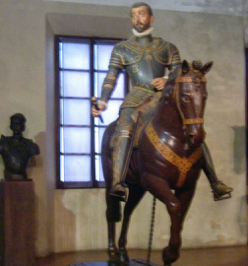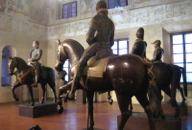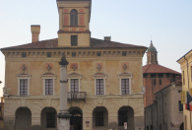PALAZZO DUCALE
DUCAL PALACE
Sabbioneta
Lombardy, Italy
Europe
November 14-15, 2008


PALAZZO DUCALE
DUCAL PALACE
Sabbioneta
Lombardy, Italy
Europe
November 14-15, 2008




The Ducal Palace, Palazzo Ducale, replaces a building destroyed by fire. It is sited on the north side of the plaza, and was the seat of public and administrative life in the state of Sabbioneta, c. mid 16th century. The building was built in 1560-61, with four floors. The street level facade has five keystone arches. Above these arches are five windows with alternating triangular and arched gables where the inscription: “VESP. D.G. DUX SABLON. I” decries and reminds all that “Vespasiano by the grace of God, first Duke of Sabbioneta”. Originally, the busts above the windows were those of Roman emperors. Today, the five busts are copies of wooden busts which were almost destroyed by fire, but which are housed within the palace today. Inside the palace, we found many interesting rooms:
•Room of Diana: Decorated with ceiling frescoes, with decorations in the grotesque style. Lunettes alternate hunting scenes with images of Olympian gods.
•Chamber of Arrows: The Ducal coast of arms is surrounded by the collar of the Golden Fleece with the original enameling and gilding.
•Room of the Duke of Alba or Golden Room: Houses a fireplace of red Verona marble supported by lions. The architrave has the ducal inscription present on the façade: “VESP. D.G. DUX SABLON. I” decries and reminds all that “Vespasiano by the grace of God, first Duke of Sabbioneta”. The ceiling is gilded with decorated and carved wooden panels.
•Room of Eagles: Houses the remains of The Calvacade, equestrian portraits of the Gonzaga family. Besides Vespasiano Gonzaga Colonna, the other three include Father Luigi Rodomonte, wearing the papal insignia of two crossed keys, Gian Francesco, first lord of the fiefdom of Sabbioneta, and Ludovico, third captain of the people belonging to the main family line of the Gonzagas of Mantua.
•Emperor’s Room: Nine large spaces divide the coffered ceiling, sculpted in 1561. Two different coats-of-arms alternate within these spaces: the Gonzaga-Colonna (V-G) and the Spanish Aragona family (A-A), the crest of the second wife. Bernardino Campi painted a number of portraits of Roman emperors in the spaces between the shelves, which originally held busts of these emperors (now housed in Mantua).
•Ancestor’s Room: A barrel vaulted room which looks out onto the balcony overlooking the square. Alberto Cavalli is thought to have painted the stuccoes and frescoes of the Gonzaga family, beginning with Luigi Corradi da Gonzaga, who won the battle to rule Mantua in 1328.
•Elephant’s Room: A room used for civil and legal debates has a frieze of a procession of elephants. The neck of each elephant, tied by a chain, is held by a human hand symbolizing reason holding back the forces of nature in order to recreate the order that is guaranteed by justice.
PHOTOS: Upper Left: Arched gable with copy of a wooden sculpture, now housed within the palace. Lower Left: View of the Palazzo Ducale. Center, Duke Vespasiano Gonzago Colonna on horseback wearing the noble order of the Golden Fleece. Upper Right: Famous room in the Palazzo Ducale, The Room of Eagles, houses what is left of a series of wooden equestrian statues, sculpted in 1587, which celebrate the military strengths of the Gonzaga family. Lower Right: View of the Palazzo Ducale with the Chiesa Dell’Incoronata, the octagonal church where Vespasiano Gonzaga Colonna’s remains are interred.


Administrative Edifice

